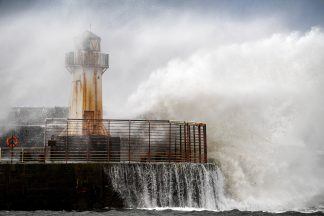The Irish Met Office, Met Eireann, have decided to name a system which is currently crossing the Atlantic as Storm Brendan, making it only the second storm of a fairly quiet season so far.
As I write this on Sunday afternoon, Brendan is a rather benign little low pressure system about 1,500 miles to the west of us, south of Greenland. By midday tomorrow he will be centred about 600 miles west of us and just north west of Ireland.
For those of you that like the figures, Brendan has a centre of about 990 millibars, but this will drop to 945 millbars by midday tomorrow. This is because the storm will engage with a 230mph jet stream at about 30,000 feet which will explosively deepen it, a process we call ‘explosive cyclogenesis’. This is also called a weather bomb, a term we hear a lot about in the press these days, but is sometimes used in error, but this time it can be called a bomb. All this means is the storm will deepen intensely with pressure dropping at least 24 millibars in 24 hours – so this storm is nearly double the ‘bomb’ requirement.
Winds will start to pick up on Sunday night and into Monday with gales widely along the north and west coast as well as the Hebrides by 6am Monday. These gales will spread to most of Scotland by the middle of Monday afternoon, while severe gales affect the north west. Winds across the Outer Hebrides will peak twice during the day with the first coming in the middle of the afternoon and then another in the evening.
All areas are at risk of seeing gusts up to 55mph. The north Aberdeenshire coast and the Northern Isles could get gusts up to 65mph, but the highest will be across the Hebrides and north west coast where gusts of 80mph are possible. If gusts do reach 80mph in the Western Isles, these will be the strongest low level gusts recorded since 2018.
As we’ve seen over the last couple of weeks, there’s been issues on the A1 due to gusty winds given turbulence coming off the hills in what are called lee waves. On Monday we could again see some particularly gusty conditions in the east through the same process of air being squeezed over the hills and mountains.
There will be a large sea swell, again with the worst hitting the west coast of Ireland with waves of up to 10 metres possible. The biggest swell for Scotland will move around the Hebrides and then to the north during Monday afternoon and evening. Large waves can be expected in many western areas, particularly the north west. Waves will reach their highest point around high tide, which occurs during Monday evening across much of the Hebrides. The wildest seas around Ayrshire will probably be just after lunchtime as winds continue to pick up and high tide occurs here.
There will be lulls this week, mainly Tuesday and Thursday night, but generally this looks like being quite a wild week with gales on and off across all areas, further rain and even the risk of significant snowfall in higher parts on Tuesday evening and night. Given the strong winds it’s likely to be quite a disruptive week for ferry travel.
I’ll leave you with this for now, but I reckon it’s going to be a busy week for me, but as always I’ll be keeping you updated with all the twists and turns in the coming days. Stay updated and stay safe.
Follow STV News on WhatsApp
Scan the QR code on your mobile device for all the latest news from around the country



























